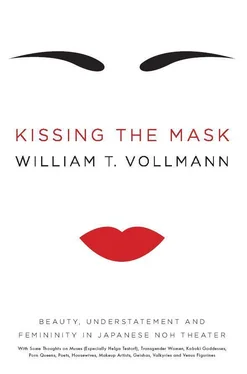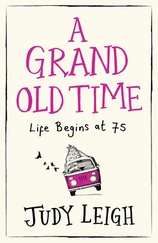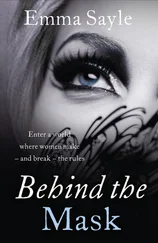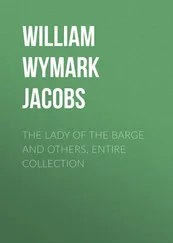Chapter 1. “The Mask Is Most Important Always”
The Noh Performances of Umewaka Rokuro
And now, on the grounds of Yasukuni Shrine, the last few cherry blossoms shiver, as do the spectators, in this April evening’s drizzly wind; and the kyogen skit about two servants who guzzle up their master’s sake proceeds loudly, coarsely beneath the Noh stage’s pagoda roof between the twin fires lit by Tokyo dignitaries an hour before, at the beginning of the entertainment; these wiggling jellies of light are, being theatrical adornments — a category which includes all earthly things — more show than substance; and I suspect that without the aid of the electric stagelights glaring in from either side of the courtyard, that painted pine on the Noh stage’s mirror-board would remain no more than a faint and complex clot of darkness. The long stage-bridge glistens, potential and void; at its far end, the rainbow curtain twitches in the breeze, like the skirt of an impatient woman; and beyond this semipermeable membrane — one of ever so many between “art” and “life” — in the mirror room, whose tatami mats feel warmly springy under one’s stockinged feet, two apprentices in blue-and-black kimonos are slowly enwrapping Mr. Umewaka Rokuro in his various shrouds. So it must have been for the preceding fifty-five generations of the Umewaka family; 1for there was an Umewaka dance troupe four centuries and more before Noh began. How did those ancientest actors prepare themselves? What masks did they wear, if any? I imagine each one taking his own silent interval, to dream upon his impending change. Thus a thousand years, fifty-five generations; this pleasant, broadfaced man marks the fifty-sixth. He is one of the most celebrated Noh actors in Japan, and has been called the best. His masked likeness appears on the cover of many a book; he performs about once a week, in Japan and out; in his spare time he sometimes reads mystery novels. The Noh corpus presently consists of about two hundred and forty plays. Mr. Umewaka keeps a hundred in his head. Standing in the doorway of this room, I can see that trembling rainbow curtain which will come to symbolize so much to me. To the right of it, a paper-windowed lattice glows in stagelight, overhanging a wall of long, horizontal slats between which the shouting actors flicker ( kyogen is traditionally performed between Noh plays, for comic relief). But within the mirror room itself one gets no view of anything. This place is, as dressing rooms should be, womb and burial chamber, where an actor’s day-to-day self gets ceremented away until the resurrection two hours hence; and another self, stranger, narrower, purer, unhurriedly germinates, preparing to come out at the appointed time, the end of the kyogen .
The apprentice who works on Mr. Umewaka from the front, kneeling at his feet, is the highest-ranking, most experienced of his kind — if he is an apprentice; for he might just as likely be a koken , a watcher-from-behind, the one who glides up to the actor as needed on stage to gather up a fallen prop or straighten his kimono. 2He may be a prestigious actor who could continue the performance should Mr. Umewaka be incapacitated. In any event, one begins as an apprentice, and one commences the apprenticeship by learning which items to present at the appropriate instant; even this, like every other aspect of Noh, is said to be difficult. Mr. Umewaka stands erect and still, gazing straight ahead into the mirror. He has entered that objectified chrysalis when one can no longer live at will, nor yet give oneself over to the expression of art. What I see is not so much a person submitting to his helpers as a force consideredly drawing in upon itself, limiting, focusing, gathering, brooding. From his kimono the helpers snip gold threads unraveled by ancientness; this costume, like so many others, dates back to the Edo period (1600–1868). 3The weaving of the old kimonos is finer than today’s, not only visually but also structurally; in them Mr. Umewaka can move more freely, or I should say less constrictedly, thanks to some peculiar fashioning of the sleeves which would now cost millions of yen to reproduce. Moreover, he tells me, the artificial fertilizer ingested by the plants on which twenty-first-century silkworms feed weakens the silk. He laments: “Now they last only a hundred and fifty years — half as long as the old ones.” Accordingly, these Edo kimonos are prized by Noh actors, and never, ever washed. They stink. The assistant at Mr. Umewaka’s back has already presented a yellow-beige kimono which will frame the inner golden one; the lead apprentice kneels at Mr. Umewaka’s feet once more, and the room roars with the faint rustling of cloth. Mr. Umewaka’s face is so calm and old. I dare not say a word to him; I must not hinder his exit from this world. Now over the black skullcap goes the black horsehair wig, whose long tresses so cleanly glisten. But first they remove the yellow-beige kimono in honor of a green one; Mr. Umewaka is concerned that yellow-beige might express too great a contrast with his new black hair. Although the fourteenth-century Noh troupes which always performed together no longer exist, Mr. Umewaka frequently performs with the same persons. Moreover, he has long since mastered his particular part, whose gestures remain unalterable. Hence he forgoes Noh’s customary day-before rehearsals. Whether he first puts his right or left foot forward, this too has been predetermined for each play — but in some respects Noh resembles a musical “jam” session, requiring certain nearly spontaneous decisions (for instance, in “Kinuta” the lead role of the ageing, perishing, abandoned wife will be played by Mr. Umewaka, who must take care not to be upstaged by the younger mask and costume of the actor who plays the ambiguously seductive maidservant) — and, since, moreover, venues vary so vastly, particularly in the quality of their stagelight, Mr. Umewaka always keeps several kimonos and wigs on hand for each part, so that he can choose and alter his beauty’s skin up to the last moment. The helpers fluff out his hair as he looks into the mirror. Then they bring him a low stool, his wig coming off again as he silently sits. “At that point I don’t think about what to do anymore,” he told me later. “Up to the point where I’m dressing, I may still be planning. But at the mirror, well, I cannot be completely nothing , or at least I can think of nothing only for an instant, but at any rate, I am both relaxed and tense in front of the mirror.” He replies briefly to their low-voiced question and they crown him with the other wig; now he exists alone before the mirror while the assistant behind him slowly unkinks each snarled hair, and he is so still while the kyogen bawls toward its boisterous end. The audience applauds. It is almost time. Five men attend him now, working at his wig, occasionally laughing very softly and gently together among themselves; and then at last the mask goes on, pale and unearthly against that black hair which they so carefully caress. They remove the mask, insert cushioning to increase its resonance for when he sings and, equally importantly, to move it farther forward, thereby widening its turning arc, and thus its expressiveness. (We will take up this subject later on.) Needless to say, the lowest objective in this fitting, if indeed it figures at all, is the actor’s comfort. The man who last smoothed his hair now kneels behind him at a discreet distance, closes his eyes, and, so it seems to me, prays, although Mr. Umewaka expressed surprise when I questioned him about this later. Meanwhile, each member of the chorus enters in turn and bows to Mr. Umewaka, who slightly inclines his head in return as he gazes into the mirror. The padded mask returns to his face. They raise his beautiful hair and tuck it just so around the face of Shuntoku-maru, the blind temple-haunting vagrant of the uncertain step.
Читать дальше












